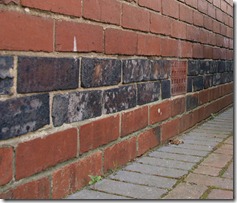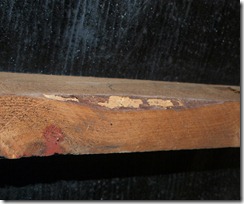A week or two ago I surveyed a house in York. My client is buying the place so of course he wants to know that the house is free of rot and damp.
My standard damp and timber survey revealed some minor wet rot (Asterostroma species), some harmless timber infestation in the roof, (Ernobius mollis), and rising damp. The pre-war semi has a dense brick DPC, formed from two courses of Staffordshire blue brick. Working fine too, other than a few areas’ where a combination of porous bed-joints, and an uneven solid floor screed; lacking a DPM, is causing problems.
I gave my client some options; de-bridging things, re-plastering and such, but basically, a diffusible cream DPC was recommended too, to guarantee success.
Anyway, my specification included removal of the salt contaminated plaster, re-plastering and the removal/re-fixing of the skirting and installation of a Safeguard DryZone diffusible cream DPC.
My client rang me last night. Seems the vendor of the house has obtained his own quote, which is two hundred pounds lower than mine, and wants to negotiate on this lower figure. My client explains “The thing is, your quote includes a lot of re-plastering, which means that we have to allow for decorating and such, ‘their’ quote is a bit lower too, but with their system, there is no need to re-plaster, we’ll save on all that decorating as well”.
So here we have a house with a long history of a small amount of moisture, rising up the face of the plaster and evaporating, leaving any minerals it contained behind – in the plaster.
Oh how I wish I had a method of drying out my client’s walls, which didn’t rely on re-plastering. Maybe in the future, nano-technology will breed an army of miniscule nano-bots, which when released, will crawl through the pores of the plaster and carefully chip away any salt, place it in their nano-rucksacks and allow transport away from site – in nano-skips. Watch this space.
In the mean time I have the unpalatable job of explaining that we need to do this disruptive and unwanted plasterwork, if the walls are to fully dry out.
But the specialist who the vendor has found says that they can inject Sovereign enviro-something-or-other and that will be that. Their quote is lower too. No mess – less expense – I’m sunk.
But wait; On the interweb I find Sovereign’s own British Board of Agrement certificate for the product – It is a high quality material and the certificate outlines essential guidance for use – guess what? On the front page it states:
- Re-plastering is necessary to prevent damage to subsequent re-decoration. To avoid split responsibility, this should be carried out by the installer, or his approved agent.
The reason for this sound advice is that the salts in the plaster are hygroscopic and so complete drying will not happen, no matter how much DPC fluid is injected. Any specialist will know this. Why then has the re-plastering being omitted from the specialist’s quote?
Well, one answer could be that installing a chemical DPC is the easy part of the job and is the bit which is needed in order to issue a guarantee, which the mortgage lender has asked for. Most clients don’t have any idea how much a chemical DPC should cost either, so they may find it hard to see an overcharge, when it is presented.
On the other hand, the re-plastering requires skill, is disruptive for the customers and cannot be charged out at a premium because , well, how much can you get away with? We are talking plastering – not brain surgery.
If this is the reason why, then for the specialist it makes perfect sense; The DPC work can be charged out at a fat premium and yet the customer will see a quote, which on the one hand is a bit lower than the ‘real specialist’s’ effort and no messy plastering, or decorating. This ruse has been in use by snake oil salesmen for decades and it still works.
I point this out to my client and send him the Sovereign pdf file – he sees the light (hurray). Furthermore the specialist installer from Derby says he has been trading ten years, yet a simple check on the company number on his letterhead (www.companieshouse.gov.uk) confirms 2007 as the year of incorporation.
Lessons for cowboys are;
- Lying about your age is only forgivable when you are young and you need a stiff drink, or access to a night club.
- Specifying any DPC system with a BBA certificate means that any client – or competitor, can find out if you’re cutting corners.
- Also, overcharging for doing half a job, whilst implying that you are doing all the necessary, is dishonest.
My advice for anyone seeking a damp-proofing or timber treatment specialist is:
- Get your own specialist – if you’re buying property, don’t rely on the vendor or his estate agent; they have completely different priorities to you.
- Carefully vet the firm or get one who has been vetted for you, by someone who knows what to look for. The Property Care Association web site is a good place to start.
- If someone has a damp-proofing solution, which is on the face of it expensive – but can save the need for re-plastering, ask why the wall is damp in the first place. If it is rising damp, then re-plastering is essential – if it is not rising damp, you don’t need their damp-proofing at all.
Dry Rot.


Some great advice.
Unfortunately in the real world things are not always assessed in the same way you have put in laymans terms here.
On the face of it, it does seem that as the price for the DPC is more expensive but saves on the replastering then it must be good value because the contractor appears not to be selling something extra.
Why shouldn’t the client believe this company if they claim to be specialists and may have ‘approval’ with a number of companies, some of which even have a ‘Her Majesty the Queen’ Royal Warrant?
If my partner were to tell me that a ‘craft stamp was needed to implement a radial 360 to project onto a Christmas card’ then I would believe her, why wouldn’t I, she is the craft ‘expert’.
I can’t call her a liar because it might just sound plausable and she ‘WOULD’ make it sound plausable. However if I were to investigate a bit more I would have a reason to doubt what she said.
I am really digressing here but what you say is valid and to the point.
Good read.